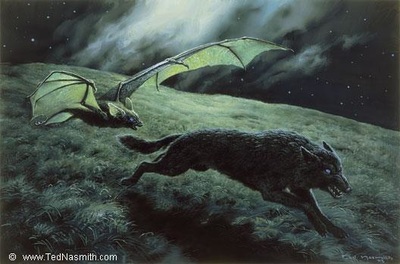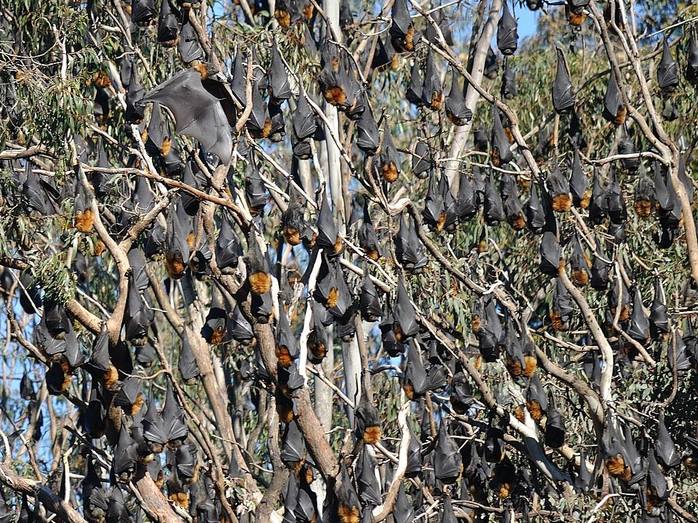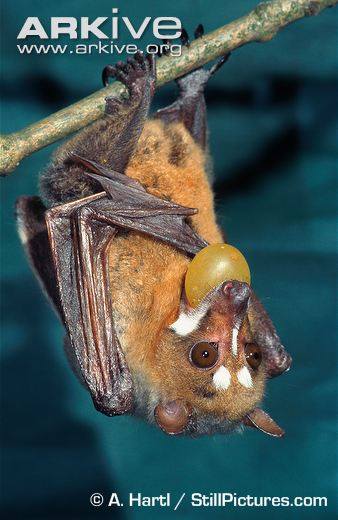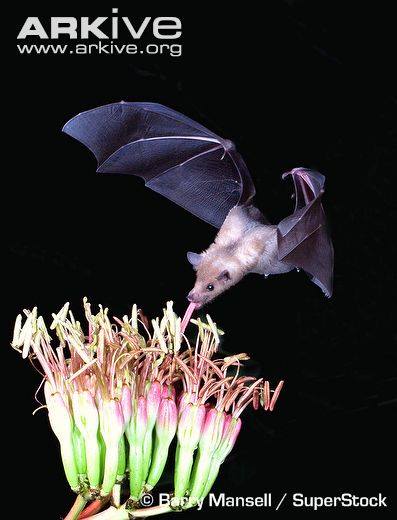|
By guest blogger: Katey Duffey Bats are usually used to instill a sense of creepiness to a scene. Stories tend to play on the fear of bats that a large number of people have. Short, upturned snouts, sharp teeth, beady eyes, large ears and wings made from a stretched membrane of skin, all combine into traits that give some people the heebie-jeebies. Not to mention, bats are also associated with those evil bloodsucking terrors of the night, vampires. Even Middle-earth had its share of vampires who had the ability to transform into giant bats. The most notable of these creatures was Thuringwethil, of the First Age, mentioned in Tolkien’s The Silmarillion. She was a vampire servant and spy of Morgoth, and was said to have “iron claws and fingered wings” (which coincidently relates to the taxonomic order that bats belong to, Chiroptera, meaning “hand-wing”). In The Hobbit book, it was indicated that some bats were “bred from darkness, and descended from vampires”, referring to the giant war bats seen in The Hobbit: Battle of the Five Armies alongside the orcs. Since many bat species already look the part for a “menacing creature of darkness”, the film did not need to do much more than increase the body size. However, giant bats of Earth are far from appearing as wicked. The most anyone needs to worry about is to be threatened by a cuteness overload. Behold, the megabats! Also known as “fruit bats” or “flying foxes” from their foxlike faces. Megabats are the largest bat species, with the Malayan flying fox being the heaviest (.9kg/2lbs) and having the longest wingspan (1.8m/6ft). They make up the Pteropodidae family of “Old World bats”, ranging throughout Africa, Asia, and Australia. While most of the world’s 1,300 bat species feed on insects, the 170 species of megabats are either frugivorous (fruit eaters) or nectarivorous (nectar drinkers). Needless to say, they are much different from the giant, terrifying bats of Dol Guldur! Therefore, unless you happen to be a delicious, juicy piece of fruit or sweet flower nectar, you have nothing to fear from these flying mammals. A specialized diet unique to bat families means that the megabats have a few equally unique adaptations. For example, along with sharp teeth that help pierce the hides of fruit, these bats have a tongue that is so long that it tucks down around their rib cage! They are also the only family of bats that are not capable of echolocation (with the exception of the Egyptian fruit bat that clicks its tongue in dark caves). Instead, megabats have an incredibly efficient sense of smell and good eyesight to help locate food. Photos: Stripe-faced fruit bat, Lesser long- nosed bat, www.arkive.org, Straw-colored fruit bat batworlds.com Since these species do not rely on echolocation to navigate, they mainly roost in trees and bushes within primary or mature secondary forests. If they do rest in a cave, they stay closer to the entrance where there is light. Similar to other bats, some megabats, such as the straw-colored fruit bat of Africa and the grey-headed flying fox of Australia, live in large colonies. They also form sub-colonies of close, social bonds in which one male may be with up to eight females. As a result of living in great numbers and having a stationary food source, these species have to migrate hundreds of kilometers in relation to seasonal tree flowering cycles or rains.
Megabats provide important eco-services. Nectarivorous bats help to pollinate flowers after they have visited other flowers, just like bees. This symbiotic relationship is a form of mutualism called “chiropterophily”. Frugivorous bats aid in seed distribution by eliminating seeds in their guano. Yet, despite the services megabats provide to the environment, habitat destruction is threatening their survival. Overhunting in retaliation from hungry bats raiding crops is another concern. However, there is hope in the battle of coexistence between farmers and bats. In Queensland, Australia, many orchards are protected by nets to keep bats out. This, in turn, decreases the instances of retaliatory killing of fruit bats. References www.batconservation.org www.batworlds.com/fruit-bat http://www.dontshootbats.com Lotr.wikia.com/wiki/bats_of_dol_guldur Mickleburgh, S., Hutson, A. and Racey, P. 1992. Old World Fruit Bats: An Action Plan for their Conservation. Gland, Switzerland: International Union for the Conservation of Nature. Kunz, T. and Fenton, M. 2003. Bat Ecology. Chicago, IL: The University of Chicago Press. Tolkiengateway.net/wiki/Thuringwethil
0 Comments
Leave a Reply. |
Blog Archive
|






 RSS Feed
RSS Feed
